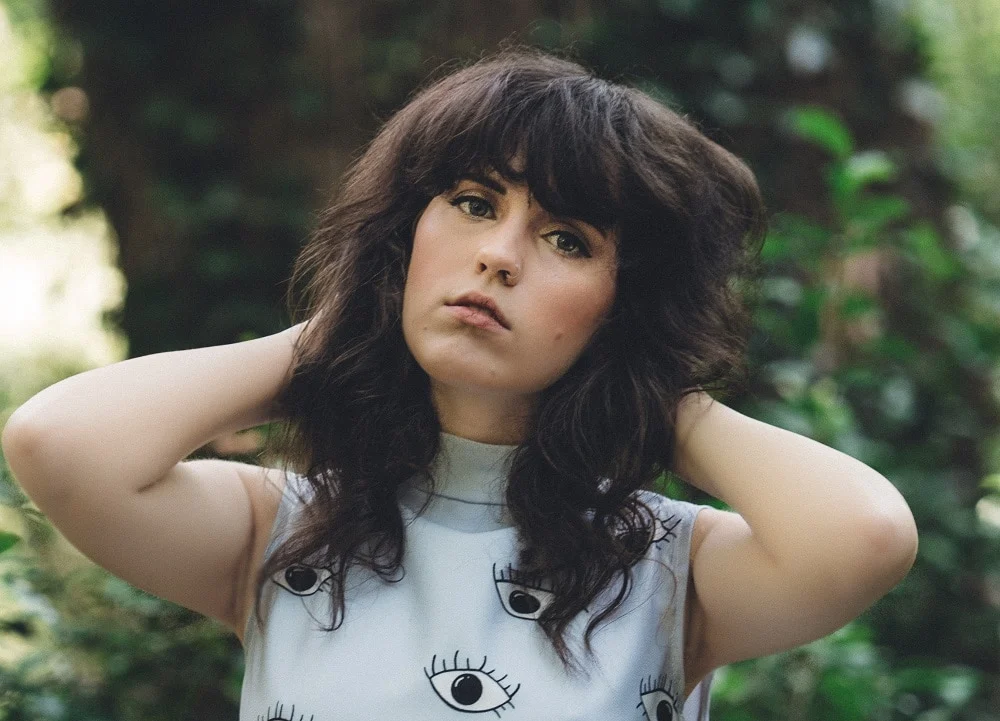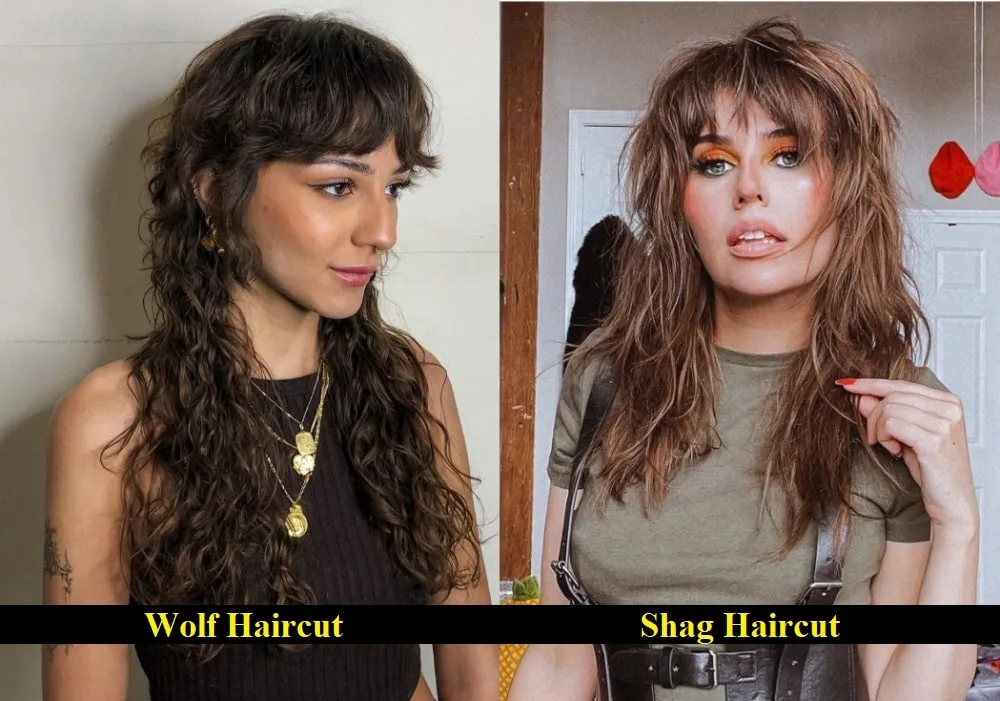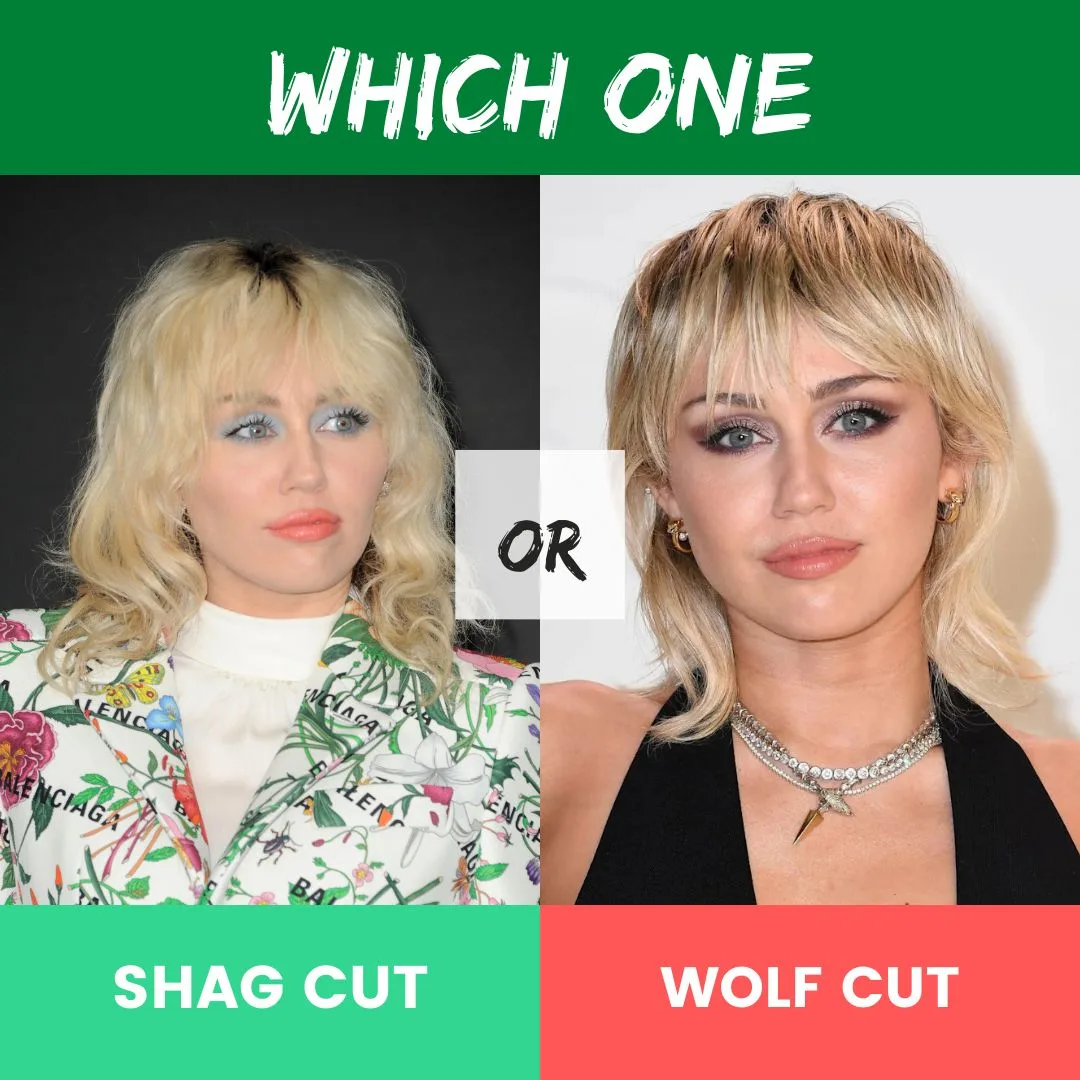If you want a grungy, mussy rock-n-roll look, you may want to get either a wolf haircut or a shag haircut. Both cuts provide an effortless grunge appearance, but when it comes to a wolf cut vs. a shag haircut, there are a few key differences to consider before you get one.
Read on to learn about the specifics behind wolf haircuts and shag haircuts to find out which is best for you.
What Is Shag Haircut?

The shag haircut rose to fame in the 70s when blonde actress Jane Fonda started wearing it. The haircut includes several layers of different lengths to create an edgy image for either sex.
The layers on the top and side of the head are feathery, and they thin out toward the fringes, making the hair appear fuller around the crown of the head.
The layers at the bottom of the head have more length, allowing clients to keep their hair long while adding volume and texture.
Some choose to add blunt bangs to their shag haircut, while others let the layers fall naturally to frame their face.
Shag haircuts have made a resurgence in recent years, likely to fit with the new generation’s intentionally messy aesthetic. Before the early 2020s, the public most recently sought after the cut in the late 90s when Jennifer Aniston popularized it as “the Rachel haircut.”
The cut is choppy, creating the exciting and fresh look Paul McGregor intended when he first cut Fonda’s hair.
What Is Wolf Cut?

The wolf cut combines elements of the shag haircut with a mullet for a wild look with a ton of personality. The layers on a wolf cut are uneven, with shorter hair at the front and the sides and longer strands toward the back of the head.
The graduated layers trace the side of the head, allowing the strands to frame the face. Some people add blunt bangs to the layers that come with the wolf cut.
The name comes from the wild final product and the ears poking out from behind the layers, which creates a bit of a wolf-boy look.
The wolf cut became popular in the 70s, shortly after the shag haircut. The recent resurgence comes from pop stars like Billie Eilish and Miley Cyrus, who fit right in with the timeless, edgy look.
What Do Wolf Cut and Shag Haircuts Look Like?

coiffeurstory|logicalharmony
The wolf and shag haircuts use choppy layers to create a fierce impression. However, there are some critical differences in the cuts.
The layers of a wolf create a face-framing look. On the other hand, the layers in a shag cut give volume to the top of the head. This difference comes from which parts of the head have layers.
In a shag haircut, the layers are on the front, back, and sides. If you were to look at a 360-degree shag haircut, you would see choppy layers everywhere.
However, a wolf haircut only layers the front and side pieces. Much like a mullet, the hair in the back stays long. The layers trace the face as opposed to circling the crown.
You can do either cut with or without bangs, and they provide a painless punk rock look.
What Are The Differences Between Wolf Cut and Shag Cut?

Shag and wolf cuts have more in common than not, but there are still some differences.
You may wonder if the wolf cut or shag haircut suits your face shape and hair type. Remember that a shag haircut will flatter most face types, but the intense volumizing look at the top of the head may make your face appear shorter.
So, many people with shag haircuts have ovular faces or angular chins. So, if you have a round face, you may want to go with a wolf haircut.
Wolf haircuts suit round faces with flattering face-framing layers, but they can create volume for any head shape without distorting the face.
Thin hair and thick hair work well for either haircut, but medium to thick is best for a shag haircut. The thicker your mane, the more volume the layers will create without styling.
If your hair is thin, you may need to style it more often to maintain that volume.
A wolf cut is ideal for thin hair. It volumizes to make your hair look thicker but requires less styling. Thick hair will do well in a wolf haircut, but it is a real knockout in a shag haircut.
If your hair is straight and you want to try one of the two, opt for a wolf cut. The results will be more noticeable around your face than on the back of your head.
So, here is a comparison table showing the differences between wolf cut and shag cut.
| Wolf Cut | Shag Haircut |
| Better for thin hair | More stylish for thick hair |
| Better for round faces | Fits ovular and angular face shapes |
| Best for wavy and curly hair, fine for straight hair | Best for wavy and curly hair |
Are There Any Similarities Between Shag and Wolf Cut?
The shag cut and wolf cut have similar wild, funky vibes. They are both experiencing a resurgence after a few decades of on-and-off relevance since their inception in the 1970s.
Neither wolf nor shag haircuts are particularly pricey. Your hairstylist will not do much more work for one of these cuts than a regular styling cut. Expect to pay anywhere between $70-$120 for a style and blowdry at your local salon.
They can also both fit most hair types, but evaluate which is better for your particular head of hair beforehand.
Wavy and curly hair is best for both haircuts. Hair with more texture will do a better job of defining the layers, creating a fuller appearance. That does not mean you cannot do one of the cuts with straight hair, but do your research first.
If you are a carefree renegade and want your hair to express your personality while looking effortlessly perfect, you might consider the wolf cut vs. shag haircut.
Wolf cuts create a voluminous, edgy look while framing your face and keeping a sleek look in the back. Shag cuts create 360 degrees of fullness and a retro appearance.
